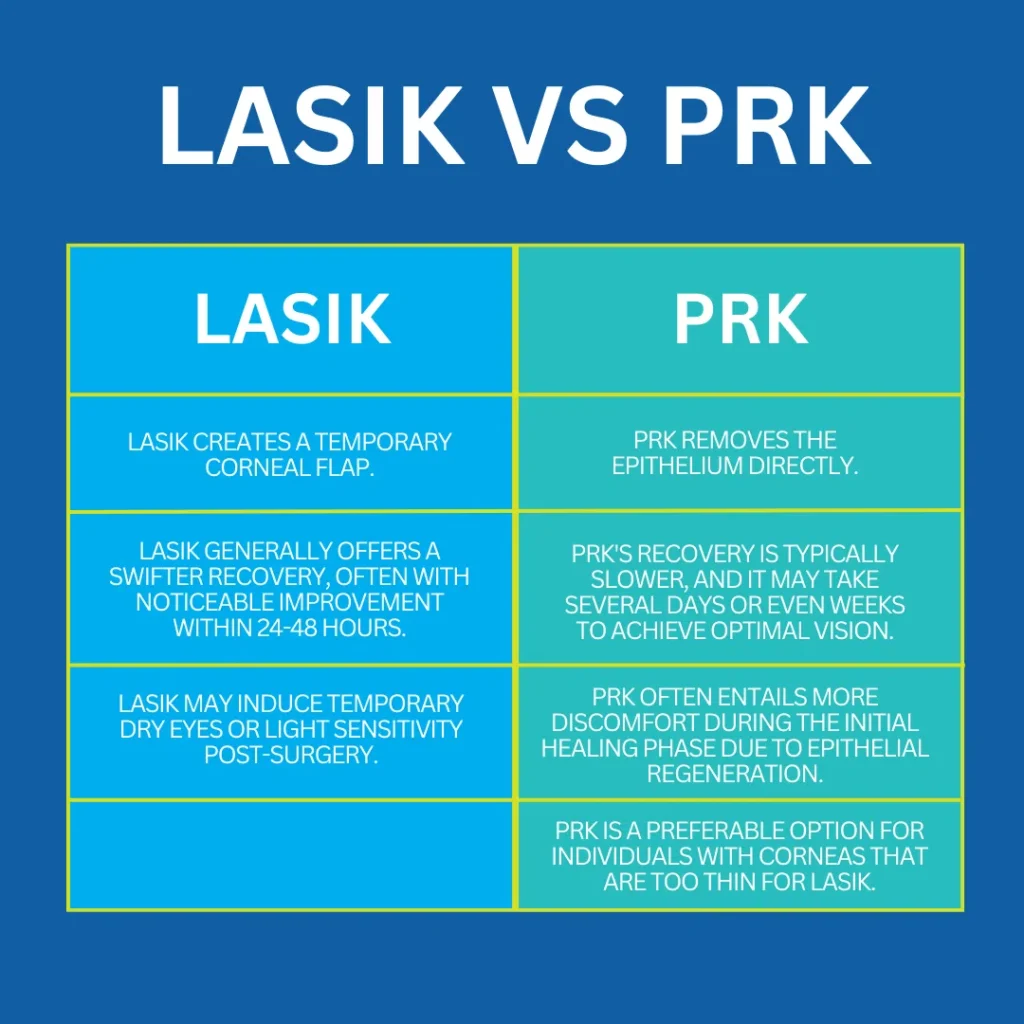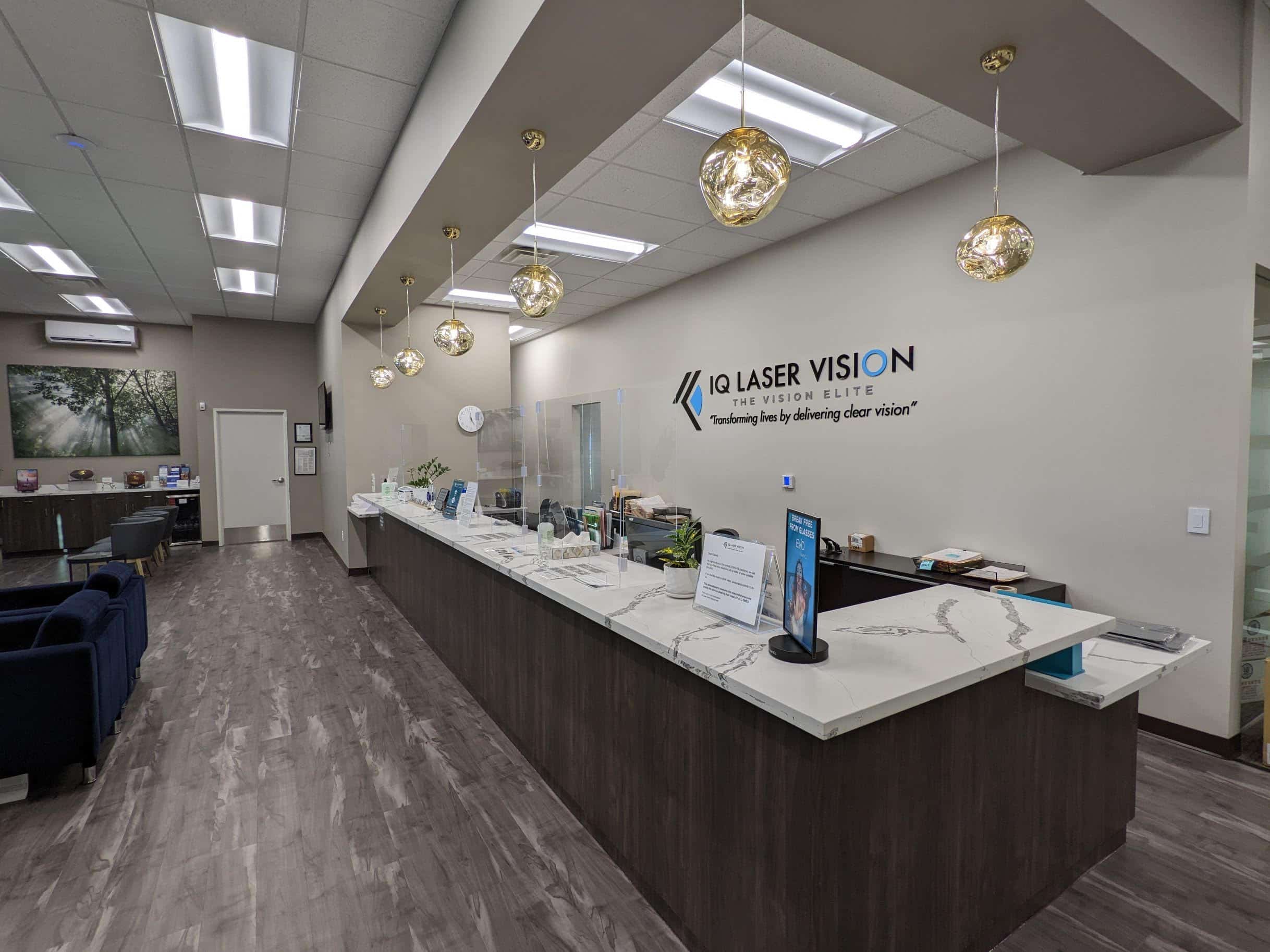
LASIK vs. PRK: Choosing the Right Procedure
For individuals wanting to shed the constraints of eyeglasses or contact lenses, refractive surgery presents a transformative opportunity. LASIK (Laser-Assisted in Situ Keratomileusis) and PRK (Photorefractive Keratectomy) are two prominent procedures that reshape the cornea, the eye’s outermost layer, to attain clearer vision. But with LASIK and PRK for your consideration, selecting the optimal solution can be perplexing. We will distinguish the differences between LASIK vs. PRK, providing clarity and insight.
LASIK: A Minimally Invasive Approach
The LASIK Procedure
LASIK boasts an ingenious two-step approach. First, a femtosecond laser creates a precise thin, circular flap in the cornea’s outermost layer (epithelium). This flap is gently folded back, exposing the underlying corneal stroma. Next, the excimer laser meticulously ablates (removes) targeted amounts of corneal tissue, reshaping it to rectify refractive errors like myopia (nearsightedness), hyperopia (farsightedness), and astigmatism. The corneal flap is then gently repositioned and naturally adheres accelerating the healing process.
Advantages of LASIK Surgery
1. Quick Recovery
Many patients experience a significant improvement in vision within 24 hours, with optimal results manifesting over a few days.
2. Predictable Outcomes
LASIK delivers precise results, with the majority of patients achieving their desired vision correction.
3. Enhanced Comfort
The creation of a corneal flap preserves the surface epithelium, leading to reduced post-operative discomfort.
4. Minimal Maintenance
Following LASIK, most patients enjoy long-term vision stability, minimizing the need for additional procedures.

LASIK Candidacy and Considerations
LASIK surgery is well-suited for individuals with moderate to severe refractive errors who desire rapid visual recovery. Candidates should meet certain criteria, including stable vision prescription, adequate corneal thickness, and absence of certain eye conditions such as keratoconus. While LASIK has revolutionized vision correction, it is not suitable for everyone. Individuals with thin corneas, severe dry eye conditions, or specific corneal irregularities may not be ideal candidates. Additionally, certain professions or activities that involve a high risk of eye injury may preclude the use of LASIK due to the potential for flap dislodgement.
PRK: The Resilient Alternative
The PRK Procedure
The epithelium, the cornea’s outermost layer, is meticulously removed using an excimer laser or mechanical means. Similar to LASIK, the excimer laser meticulously ablates corneal tissue to rectify refractive errors. However, unlike LASIK, PRK doesn’t involve creating a corneal flap. Instead, a natural bandage (epithelial layer) regenerates over the treated area within a few days.
Advantages of PRK Surgery

1. Corneal Preservation
PRK eliminates the risk of flap-related complications, making it a preferred choice for patients with thinner corneas or occupations that pose a higher risk of eye trauma.
2. Suitability for Thin Corneas
Since PRK does not require the creation of a corneal flap, it is often recommended for individuals with thinner corneas who may not be suitable candidates for LASIK.
3. Reduced Risk of Dry Eye
By avoiding the creation of a corneal flap, PRK reduces the risk of post-operative dry eye symptoms.
Candidate Suitability for PRK
PRK is often favored for individuals with thin corneas, certain corneal irregularities, or professions that pose a higher risk of eye trauma. The absence of a corneal flap eliminates the potential for flap-related complications, making PRK a suitable option for those who may not be ideal candidates for LASIK. Candidates should have realistic expectations regarding the recovery process, as visual recovery may be slower compared to LASIK.
Unveiling the Key Distinctions: LASIK vs. PRK
While LASIK vs. PRK culminate in improved vision, they diverge in their approaches and suitability for certain individuals. Here’s a closer overview of their core distinctions:

Candidate Selection: Who is Ideal for LASIK vs. PRK?
The suitability for LASIK vs. PRK hinges on several factors, including corneal thickness, the nature and severity of your refractive error, and your tolerance for discomfort. Here’s a glimpse into ideal candidates for each procedure:
LASIK: Well-suited for individuals with adequate corneal thickness and who prioritize a swifter recovery.
PRK: Ideal for those with corneas that are too thin for LASIK or individuals engaged in occupations or activities that could dislodge a LASIK flap (e. g., frequent contact sports).
LASIK vs. Cataract Surgery: Understanding the Differences and Compatibility
Many people who have undergone LASIK eye surgery to correct their vision in their younger years wonder if they can still have cataract surgery later in life. The answer is YES! Moreover, many do not realize that you can even have LASIK after cataract surgery if you have residual vision correction needs.
LASIK vs. Cataract: Understanding the Difference:
LASIK Surgery: This procedure reshapes the cornea, the clear dome at the front of the eye, to improve your ability to focus light and achieve clearer vision.
Cataract Surgery: This procedure replaces the clouded natural lens of the eye, located behind the iris, with a clear artificial lens, restoring vision clarity.
Cataract Surgery for Non-LASIK Patients:
Selecting the appropriate lens can offer excellent vision both at a distance and up close. For individuals who haven’t undergone LASIK, cataract surgery typically provides a simple and reliable solution. The implanted lens often eliminates the need for distance vision glasses, although reading glasses might still be necessary.
Cataract Surgery After LASIK:
Even with a LASIK history, modern technology allows for precise eye measurements to ensure successful cataract surgery. It can effectively address vision concerns even for individuals who have undergone LASIK previously. While complete LASIK records are ideal for optimal lens selection, alternative approaches are available to achieve a successful outcome.
The Importance of Understanding LASIK vs. Cataract Surgery:
Understanding the differences between LASIK vs. cataract surgery is crucial for those considering vision correction procedures. LASIK surgery focuses on reshaping the cornea to correct vision issues like myopia, hyperopia, and astigmatism. In contrast, cataract surgery involves removing the eye’s natural lens that has become cloudy and replacing it with an artificial lens to restore clear vision.
Seeking Professional Advice on LASIK vs. PRK:
If you have further questions about LASIK, cataracts, or your individual eligibility for either surgery, consult a qualified eye care professional. They can assess your specific situation and provide personalized guidance. Understanding LASIK vs. cataract surgery and their compatibility can help you make informed decisions about your eye care needs.
For more information, visit our LASIK Services page and book your free consultation now!
Conclusion:
In summary, LASIK surgery and cataract surgery serve different purposes but can complement each other in managing vision health. Modern advancements allow for successful cataract surgery even after LASIK. Always seek professional advice to determine the best approach for your vision correction needs.
For further reading, check out this comprehensive guide on LASIK vs. Cataract Surgery.
By understanding the differences and compatibilities between these procedures, you can make well-informed decisions about your eye care journey.























